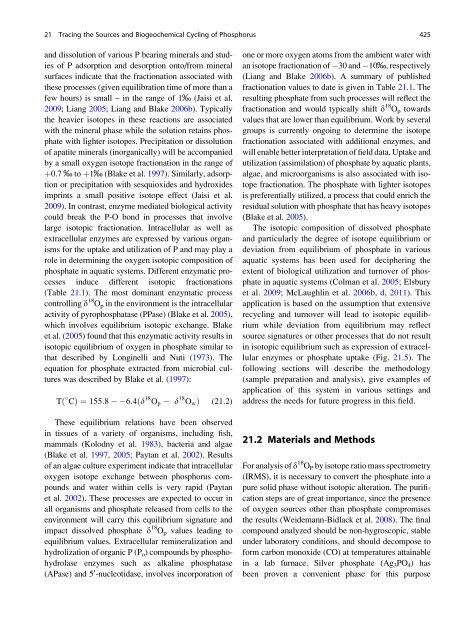Chapter 21. Adina Paytan. Tracing the Sources and Biogeochemical Cycling of Phosphorus in Aquatic Systems Using Isotopes of Oxygen in Phosphate
Create successful ePaper yourself
Turn your PDF publications into a flip-book with our unique Google optimized e-Paper software.
21 <strong>Trac<strong>in</strong>g</strong> <strong>the</strong> <strong>Sources</strong> <strong>and</strong> <strong>Biogeochemical</strong> <strong>Cycl<strong>in</strong>g</strong> <strong>of</strong> <strong>Phosphorus</strong> 425<br />
<strong>and</strong> dissolution <strong>of</strong> various P bear<strong>in</strong>g m<strong>in</strong>erals <strong>and</strong> studies<br />
<strong>of</strong> P adsorption <strong>and</strong> desorption onto/from m<strong>in</strong>eral<br />
surfaces <strong>in</strong>dicate that <strong>the</strong> fractionation associated with<br />
<strong>the</strong>se processes (given equilibration time <strong>of</strong> more than a<br />
few hours) is small – <strong>in</strong> <strong>the</strong> range <strong>of</strong> 1‰ (Jaisi et al.<br />
2009; Liang 2005; Liang <strong>and</strong> Blake 2006b). Typically<br />
<strong>the</strong> heavier isotopes <strong>in</strong> <strong>the</strong>se reactions are associated<br />
with <strong>the</strong> m<strong>in</strong>eral phase while <strong>the</strong> solution reta<strong>in</strong>s phosphate<br />
with lighter isotopes. Precipitation or dissolution<br />
<strong>of</strong> apatite m<strong>in</strong>erals (<strong>in</strong>organically) will be accompanied<br />
by a small oxygen isotope fractionation <strong>in</strong> <strong>the</strong> range <strong>of</strong><br />
þ0.7 ‰ to þ1‰ (Blake et al. 1997). Similarly, adsorption<br />
or precipitation with sesquioxides <strong>and</strong> hydroxides<br />
impr<strong>in</strong>ts a small positive isotope effect (Jaisi et al.<br />
2009). In contrast, enzyme mediated biological activity<br />
could break <strong>the</strong> P-O bond <strong>in</strong> processes that <strong>in</strong>volve<br />
large isotopic fractionation. Intracellular as well as<br />
extracellular enzymes are expressed by various organisms<br />
for <strong>the</strong> uptake <strong>and</strong> utilization <strong>of</strong> P <strong>and</strong> may play a<br />
role <strong>in</strong> determ<strong>in</strong><strong>in</strong>g <strong>the</strong> oxygen isotopic composition <strong>of</strong><br />
phosphate <strong>in</strong> aquatic systems. Different enzymatic processes<br />
<strong>in</strong>duce different isotopic fractionations<br />
(Table <strong>21.</strong>1). The most dom<strong>in</strong>ant enzymatic process<br />
controll<strong>in</strong>g d 18 O p <strong>in</strong> <strong>the</strong> environment is <strong>the</strong> <strong>in</strong>tracellular<br />
activity <strong>of</strong> pyrophosphatase (PPase) (Blake et al. 2005),<br />
which <strong>in</strong>volves equilibrium isotopic exchange. Blake<br />
et al. (2005) found that this enzymatic activity results <strong>in</strong><br />
isotopic equilibrium <strong>of</strong> oxygen <strong>in</strong> phosphate similar to<br />
that described by Long<strong>in</strong>elli <strong>and</strong> Nuti (1973). The<br />
equation for phosphate extracted from microbial cultures<br />
was described by Blake et al. (1997):<br />
Tð CÞ¼155:8 6:4ðd 18 O p d 18 O w Þ (<strong>21.</strong>2)<br />
These equilibrium relations have been observed<br />
<strong>in</strong> tissues <strong>of</strong> a variety <strong>of</strong> organisms, <strong>in</strong>clud<strong>in</strong>g fish,<br />
mammals (Kolodny et al. 1983), bacteria <strong>and</strong> algae<br />
(Blake et al. 1997, 2005; <strong>Paytan</strong>etal.2002). Results<br />
<strong>of</strong> an algae culture experiment <strong>in</strong>dicate that <strong>in</strong>tracellular<br />
oxygen isotope exchange between phosphorus compounds<br />
<strong>and</strong> water with<strong>in</strong> cells is very rapid (<strong>Paytan</strong><br />
et al. 2002). These processes are expected to occur <strong>in</strong><br />
all organisms <strong>and</strong> phosphate released from cells to <strong>the</strong><br />
environment will carry this equilibrium signature <strong>and</strong><br />
impact dissolved phosphate d 18 O p values lead<strong>in</strong>g to<br />
equilibrium values. Extracellular rem<strong>in</strong>eralization <strong>and</strong><br />
hydrolization <strong>of</strong> organic P (P o ) compounds by phosphohydrolase<br />
enzymes such as alkal<strong>in</strong>e phosphatase<br />
(APase) <strong>and</strong> 5 0 -nucleotidase, <strong>in</strong>volves <strong>in</strong>corporation <strong>of</strong><br />
one or more oxygen atoms from <strong>the</strong> ambient water with<br />
an isotope fractionation <strong>of</strong> 30 <strong>and</strong> 10‰,respectively<br />
(Liang <strong>and</strong> Blake 2006b). A summary <strong>of</strong> published<br />
fractionation values to date is given <strong>in</strong> Table <strong>21.</strong>1. The<br />
result<strong>in</strong>g phosphate from such processes will reflect <strong>the</strong><br />
fractionation <strong>and</strong> would typically shift d 18 O p towards<br />
values that are lower than equilibrium. Work by several<br />
groups is currently ongo<strong>in</strong>g to determ<strong>in</strong>e <strong>the</strong> isotope<br />
fractionation associated with additional enzymes, <strong>and</strong><br />
will enable better <strong>in</strong>terpretation <strong>of</strong> field data. Uptake <strong>and</strong><br />
utilization (assimilation) <strong>of</strong> phosphate by aquatic plants,<br />
algae, <strong>and</strong> microorganisms is also associated with isotope<br />
fractionation. The phosphate with lighter isotopes<br />
is preferentially utilized, a process that could enrich <strong>the</strong><br />
residual solution with phosphate that has heavy isotopes<br />
(Blake et al. 2005).<br />
The isotopic composition <strong>of</strong> dissolved phosphate<br />
<strong>and</strong> particularly <strong>the</strong> degree <strong>of</strong> isotope equilibrium or<br />
deviation from equilibrium <strong>of</strong> phosphate <strong>in</strong> various<br />
aquatic systems has been used for decipher<strong>in</strong>g <strong>the</strong><br />
extent <strong>of</strong> biological utilization <strong>and</strong> turnover <strong>of</strong> phosphate<br />
<strong>in</strong> aquatic systems (Colman et al. 2005; Elsbury<br />
et al. 2009; McLaughl<strong>in</strong> et al. 2006b, d, 2011). This<br />
application is based on <strong>the</strong> assumption that extensive<br />
recycl<strong>in</strong>g <strong>and</strong> turnover will lead to isotopic equilibrium<br />
while deviation from equilibrium may reflect<br />
source signatures or o<strong>the</strong>r processes that do not result<br />
<strong>in</strong> isotopic equilibrium such as expression <strong>of</strong> extracellular<br />
enzymes or phosphate uptake (Fig. <strong>21.</strong>5). The<br />
follow<strong>in</strong>g sections will describe <strong>the</strong> methodology<br />
(sample preparation <strong>and</strong> analysis), give examples <strong>of</strong><br />
application <strong>of</strong> this system <strong>in</strong> various sett<strong>in</strong>gs <strong>and</strong><br />
address <strong>the</strong> needs for future progress <strong>in</strong> this field.<br />
<strong>21.</strong>2 Materials <strong>and</strong> Methods<br />
For analysis <strong>of</strong> d 18 O P by isotope ratio mass spectrometry<br />
(IRMS), it is necessary to convert <strong>the</strong> phosphate <strong>in</strong>to a<br />
pure solid phase without isotopic alteration. The purification<br />
steps are <strong>of</strong> great importance, s<strong>in</strong>ce <strong>the</strong> presence<br />
<strong>of</strong> oxygen sources o<strong>the</strong>r than phosphate compromises<br />
<strong>the</strong> results (Weidemann-Bidlack et al. 2008). The f<strong>in</strong>al<br />
compound analyzed should be non-hygroscopic, stable<br />
under laboratory conditions, <strong>and</strong> should decompose to<br />
form carbon monoxide (CO) at temperatures atta<strong>in</strong>able<br />
<strong>in</strong> a lab furnace. Silver phosphate (Ag 3 PO 4 ) has<br />
been proven a convenient phase for this purpose



